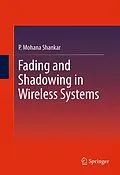In recent decades, growth in the field of wireless communications has led to an exponential rise in the number of journals catering to the research community. Still unmet, however, is the need to fully and comprehensively understand the effects of channel degradation brought on by the statistical fluctuations in the channel. These fluctuations mainly manifest as variations in signal power observed in the channel generally modeled using a variety of probability distributions, both in straight forms as well as in compound forms. While the former might explain some of the effects, it is the latter, namely, the compound models, which incorporate both short term and long term power fluctuations in the channel, explain the much more complex nature of the signals in these channels. Fading and Shadowing in Wireless Systems offers a pedagogical approach to the topic, with insight into the modeling and analysis of fading and shadowing.
Beginning with statistical background and digital communications, the book is formulated to follow the details of modeling of the statistical fluctuations of signals in these channels. The author describes degradations in the channels arising from the statistical fluctuations in terms of various measures. This is followed by a discussion of diversity and associated signal processing algorithms to mitigate the effects of statistical fluctuations in the channel as well as quantitative measures of improvements brought on by diversity. The book also examines the effects of cochannel interference.
Zusammenfassung
The study of signal transmission and deterioration in signal characteristics as the signal propagates through wireless channels is of great significance. The book presents a comprehensive view of channel degradation arising from fading and shadowing. Various statistical models including simple, hybrid, compound, complex and cascaded ones are presented with detailed derivations along with measures to quantify the deterioration such as the amount of fading, error rates and outage probabilities. The models range from the Rayleigh and Rician through Suzuki, generalized K, cascaded and alpha-mu and similar ones. This is followed by the analysis of mitigation of fading and shadowing through diversity (simple, hybrid, micro- and macro- level) and combining algorithms. The density and distribution functions, error rates and outages are derived and results analyzed to quantify the improvements. The effects of co-channel interference before and after the implementation of diversity are also analyzed. To facilitate easy understanding of the models and analysis, the background information in terms of probability and random variables is presented with relevant derivations of densities of linear and nonlinear transformation of random variables, the sums, products, ratios as well as order statistics of random variables of all types. The book also provides material on digital modems of interest in wireless systems. Thus, the book with 1100+ equations and 350+ Matlab generated figures and tables is an ideal source for students, educators, researchers and professionals in wireless communications allowing access to information currently unavailable.
Inhalt
Overview.- Concepts of Probability and Statistics.- Modems for Wireless Communications.- Modeling of Fading and Shadowing.- Diversity Techniques.- Interference in Wireless Channels.
